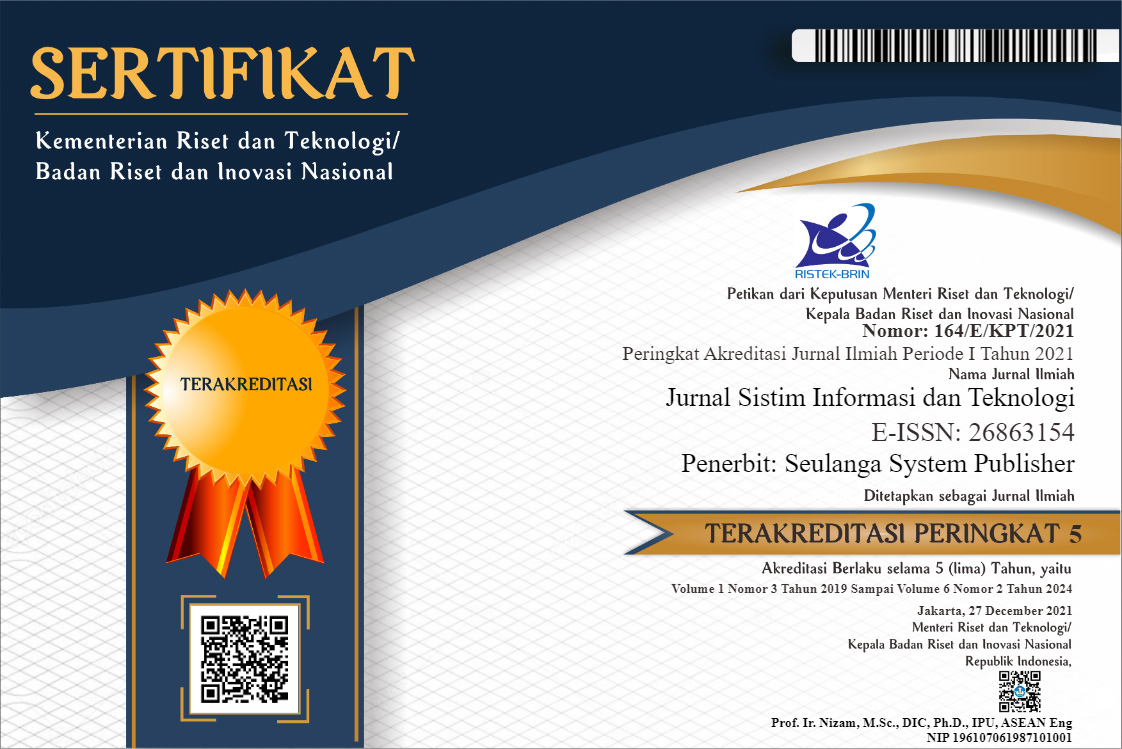Klasterisasi Tingkat Masa Studi Tepat Waktu Mahasiswa Menggunakan Algoritma K-Medoids
DOI:
https://doi.org/10.37034/jsisfotek.v3i3.60Keywords:
Clusterization, Student Graduation, K-Medoids Algorithm, Students, Study PeriodAbstract
The period of study on time is one of the parameters of a student's success in completing college to obtain a bachelor's degree. A student is said to have completed his studies on time if he is able to complete his studies less than or equal to the predetermined time. Academic Provides facilities to find out the estimated time of student graduation. By providing information on which students are included in the cluster, they can complete their studies on time and which students do not complete their studies on time. In this study, the data processed were data from students who had graduated in the previous year. Then the data is processed using rapidminer software. This study applies the K-Medoids algorithm in clustering. The result of testing this method is to determine the student clusters who can complete the study period on time and the student clusters who cannot complete the study period on time. This research is expected to contribute to the campus in evaluating the tendency of students to complete their studies on time or not. The results of the evaluation of performance can produce information for study programs, lecturers and students in making policies.
References
Hardiyanti, F., Tambunan, H. S., & Saragih, I. S. (2019). Penerapan Metode K-Medoids Clustering pada Penanganan Kasus Diare di Indonesia. KOMIK (Konferensi Nasional Teknologi Informasi dan Komputer), 3(1), 2598-4645. DOI: http://dx.doi.org/10.30865/komik.v3i1.1666 .
Rofiqi, A. Y. (2017). Clustering Berita Olahraga Berbahasa Indonesia Menggunakan Metode K-Medoid Bersyarat. Jurnal Simantec, 6(1).
Gita, T. P. (2015). Penerapan Metode Klastering dengan Algoritma K-Means Untuk Prediksi Kelulusan Mahasiswa Pada Program Studi Teknik Informatika Strata Satu. Udinus Repository.
Riadi, M., Azhar, Y., & Wicaksono, G. W. (2020). Implementasi Algoritma C5.0 dan K-Medoids Untuk Klasterisasi Ibu Hamil Beresiko Tinggi. Jurnal Repositor, 2(4), 511-524. DOI: http://doi:10.22219/repositor.v2i4.696 .
Buulolo, E., Syahputra, R., & Fau, A. (2020). Algoritma K-Medoids Untuk Menentukan Calon Mahasiswa yang Layak Mendapatkan Beasiswa Bidikmisi di Universitas Budi Darma. Jurnal Media Informatika Budidarma, 4(3). DOI: http://dx.doi.org/10.30865/mib.v4i3.2240 .
Arianto, J. (2019). Penerapan Data Mining Untuk Pengelompokan Penduduk Kurang Mampu Desa Sambirejo Timur dengan Algoritma K-Medoids (Studi Kasus Kantor Kepala Desa Sambirejo Timur). Komik (Konferensi Nasional Teknologi Informasi dan Komputer), 3(1). DOI: http://dx.doi.org/10.30865/komik.v3i1.1660 .
Riyanto, B. (2019). Penerapan Algoritma K-Medoids Clustering Untuk Pengelompokkan Penyebaran Diare di Kota Medan (Studi Kasus: Kantor Dinas Kesehatan Kota Medan). KOMIK (Konferensi Nasional Teknologi Informasi dan Komputer), 3(1). DOI: http://dx.doi.org/10.30865/komik.v3i1.1659 .
Wahyuli, D., Handrizal, H., Parlina, I., Windarto, A. P., Suhendro, D., & Wanto, A. (2019). Mengelompokkan Garis Kemiskinan Menurut Provinsi Menggunakan Algoritma K-Medoids. Prosiding Seminar Nasional Riset Information Science (SENARIS), 1. DOI: http://dx.doi.org/10.30645/senaris.v1i0.51 .
Ningsih, S., Suhada, S., Dewi, R., & Windarto, A. P. (2019). Pengklasteran Dokumen Tentang Dispensasi Nikah Menggunakan Algoritma K-Medoids. Prosiding Seminar Nasional Riset Information Science (SENARIS), 1. DOI: http://dx.doi.org/10.30645/senaris.v1i0.74 .
Defiyanti, S., Jajuli, M., & Rohmawati, N. (2017). Optimalisasi K-MEDOID dalam Pengklasteran Mahasiswa Pelamar Beasiswa dengan Cubic Clustering Criterion. Jurnal Nasional Teknologi dan Sistem Informasi, 3(1), 211–218. DOI: http://doi:10.25077/teknosi.v3i1.2017.211-218 .
Triyanto, W. A. (2015). Algoritma K-Medoids Untuk Penentuan Strategi PemasaranProduk. Jurnal SIMETRIS, 6(1), 2252-4983. DOI: https://doi.org/10.24176/simet.v6i1.254 .
Anggreini, N. L. (2019). Teknik Clustering dengan Algoritma K-Medoids Untuk Menangani Strategi Promosi di Politeknik TEDC Bandung. Jurnal Teknologi Informasi dan Pendidikan, 12(2), 2086-4981. DOI: https://doi.org/10.24036/tip.v12i2.215 .
AS, W., Aidid, M. K., & Nusrang, M. (2019). Pengelompokan Kabupaten/Kota Provinsi Sulawesi Selatan dan Barat Berdasarkan Angka Partisipasi Pendidikan SMA/SMK/MA Menggunakan K-Medoid dan CLARA. VARIANSI: Journal of Statistics and Its Application on Teaching and Research, 1(3), 48. DOI: https://doi.org/10.35580/variansiunm12899 .
Kamila, I., Khairunnisa, U., & Mustakim, M. (2019). Perbandingan Algoritma K-Means dan K-Medoids untuk Pengelompokan Data Transaksi Bongkar Muat di Provinsi Riau. Jurnal Ilmiah Rekayasa dan Manajemen Sistem Informasi, 5(1). DOI: http://dx.doi.org/10.24014/rmsi.v5i1.7381 .
Farahdinna, F., Nurdiansyah, I., Suryani, A., & Wibowo, A. (2019). Perbandingan Algoritma K-Means dan K-Medoids dalam Klasterisasi Produk Asuransi Perusahaan Nasional. Jurnal Ilmiah Fifo, 11(2). DOI: http://dx.doi.org/10.22441/fifo.2019.v11i2.010









